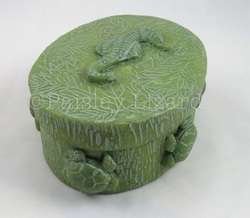Prices, and how to arrive at them, can be an uncomfortable topic for many artists and craftspeople. It is one of my least favorite aspects of operating a small business, right after keeping track of paperwork for taxes.
There are four basic elements to factor into the price of an item, whether it was handmade or mass-produced. The first, and usually easiest to calculate, is the cost of materials from which the item is made. The second is the cost of labor to produce the item. The third is expenses associated with operating a business, like shipping charges, printing fees, tools, rent, and advertising costs. The fourth is profit margin.

Gemstone beaded necklace and earring set handmade by Paisley Lizard
But I’m not here to explain the math behind pricing handmade goods. There are spreadsheets and formulas, and whatnot for that (like this one from Etsy). I’m up here on my soapbox because of how often I see talented people set prices that under-value their handmade goods, and by association, all things handmade. Whether a person makes jewelry (or knits scarves, or paints rocks, or carves presidential portraits onto popsicle sticks) as a hobby or as their sole source of income, how they price their items reflects on the entire handmade community.

Polymer clay covered keepsake box handmade by Paisley Lizard
Whether someone sells their work “at cost” – meaning they’re basically only passing on the costs of materials and not charging for their time or overhead, much less making a profit – because they don’t need the income or because they don’t value their creativity or their time enough to charge more, the net effect is people seeing those low prices can believe handmade = cheap. This can be detrimental to every artist trying to making a living from selling their creations and to perceptions about the value of art in general.

Artisan lampwork beaded bracelet handmade by Paisley Lizard.
I happen to have a day job, and making jewelry is not my sole source of income. That doesn’t mean I should price my items charitably. I won’t say I put my blood, sweat, and tears into each piece I create: although I have bled after stabbing myself with wire; it can get pretty darned hot in the kitchen when baking polymer clay; and I have cried in frustration when something just won’t come together as I envisioned.
My point is, a handmade item is worth more than the sum of its parts. There is value in the artist’s time and their creative process. How much should an artist charge for their time? How much is their “vision” worth? Only the artist themself can answer that.
If you’re an artist – struggling to make a living from your work or moonlighting for fun – don’t undervalue your time or your design ideas. Pay yourself a fair wage. Handmade is unique, it’s original, it’s something not everyone can do. It has value above and beyond the cost of materials.
As for profit margin: factor one into your prices. If you don’t need the money, there’s likely a charitable organization or 20 that would appreciate your support. And your customers can feel all virtuous and stuff knowing a portion of their purchase helped a worthy cause.
For those who buy handmade, your recognition that handmade is not synonymous with inexpensive or cheap, and your willingness to support small businesses and independent artists, are greatly appreciated.


